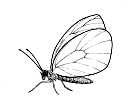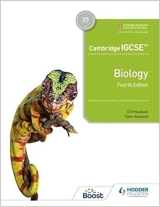The Large White Butterfly
The large white is a migratory butterfly, and many of them fly across the Channel to Britain in the summer.
For illustrations to accompany this article see Insect Life-Cycles
See also: Video of butterfly metamorphosis
Eggs. After mating, the female lays her eggs in batches of from 6 to 100, usually on the underside of leaves of plants in the cabbage family where they are attached by a sticky secretion. The egg is somewhat bottle-shaped, yellow or orange with a ribbed pattern over its surface It contains yolk, which nourishes the developing larva, and a small hole, micropyle, at the top, which admitted a sperm when the egg was fertilized in the female's oviduct and which now allows air to reach the embryo. In warm weather, after about a week the eggs hatch and small larvae called caterpillars eat their way out of the eggshells and devour the remains of them. Their egg shells, indeed, seem to be quite vital to their continued development. Next, they feed on the cabbage leaf, biting off pieces with their jaws.
Caterpillars. The body of the caterpillar is cylindrical and yellow with black markings. It consists of a head and thirteen segments. On the head are biting jaws which move transversely, and a pair of small antennae. Inside the head a pair of salivary glands form silk-producing organs, and their ducts project in a tube, the spinneret, behind the jaws. Liquid secreted by these glands passes through the spinneret and hardens in the air to form a thread of silk. The caterpillar uses this to attach itself when walking on a slippery surface, secreting a zigzag trail of thread which sticks to the surface and can be gripped by the legs. The eyes are simple ocelli, three on each side. They consist of a single lens with light-sensitive cells beneath. It is likely that they can detect only the difference between light and darkness and cannot form images.
The first three body segments correspond to the thorax of the adult and the remaining ten become its abdomen. There is a spiracle on both sides of the first thoracic segment and the first eight abdominal segments. The thoracic segments each bear a pair of jointed "true" legs with claws at the end. These correspond to the legs of the adult. The third to sixth abdominal segments bear a pair of unjointed, fleshy projections with rows of tiny hooks at the end. These are called prolegs and are not present in the adult. The last segment bears a pair of claspers similar to the prolegs. As it grows, the caterpillar sheds its cuticle four times.
Pupation.
When it has reached full size the caterpillar leaves the cabbage plant and migrates to a dry, sheltered place such as a wall or a tree. It settles vertically on this, head uppermost, and attaches its thorax to it by spinning a girdle of silk. Its body shortens and swells in the thoracic region, splitting its last larval cuticle down the back after about two days. By rhythmic contractions of the body it pushes off the old cuticle. On the last segment has formed a group of hooks, the cremaster, and when the cuticle is shed the hooks anchor into a pad of silk that the caterpillar has previously spun.What emerges from this last larval ecdysis is called the pupa, or chrysalis It is pale and soft at first but hardens and darkens, often approximately matching the colour of its background. From the appearance of the pupa it is clear that before the final moult, extensive changes have taken place, since the outline of the adult's legs, proboscis, eyes and wings can be seen in its cuticle.
During the next two or three weeks the pupa remains more or less motionless, but inside it larval organs are being digested away and cells which have remained dormant begin to multiply and give rise to the organs of the adult. At the end of this period the pupal skin splits down the back and the adult insect pulls itself out of the skin. The wings are crumpled and folded at this stage, but blood is forced into them down the "veins" and they expand and finally harden and dry.
Adult.
The body of the imago consists of a distinct head, thorax and abdomen. There are no legs on the abdomen, but attached to the thorax are two pairs of wings and three pairs of legs. On the head are two large, compound eyes consisting of about six thousand separate lenses with light-sensitive cells beneath them. The compound eyes are thought to form fairly distinct images of close objects and are particularly sensitive to movements.On the head there are two long antennae which bear organs of smell. In moths this sense is very acute, but in butterflies it is less important, probably because of their day-flying habits.
The proboscis consists of two long processes, grooved along their inner surfaces so that when they are placed together they form a tube through which nectar from flowers can be sucked When not in use the proboscis is coiled beneath the head.
The two pairs of wings on the thorax are broad and supported by a network of "veins". They are covered with tiny scales which give the characteristic wing patterns and colours, partly by the way they reflect and absorb light according to their angle, but largely because of the pigment they contain. The fore-wings overlap the hind-wings, so that in flight both pairs move together. Butterflies at rest often hold their wings vertically above their bodies, while most moths rest with outspread wings.
The legs consist of nine segments: the first two, coxa and trochanter are very short; the next two, femur and tibia are long, and there are five short joints in the foot or tarsus. In some species the last pair of legs bear taste organs in the tarsi, and the butterfly will uncoil its proboscis if these legs are dipped into sugar solution or fruit juice.
The thorax is covered with "hairs" or setae. These are present on the bodies of all insects. In structure they are quite unlike the hairs of mammals and they have sensitive organs of touch at
their bases.
Habits.
The adult butterflies are attracted to flowers by their sight and smell; they feed by sucking nectar from the nectaries through the long proboscis. Butterflies are believed to be able to distinguish colour, but not all species are equally sensitive to the same colours. The large white's eye is particularly sensitive to red and purple.The male is usually attracted to the female by the scent which she exudes. He flutters round her and stimulates her with his scent which comes from certain glandular areas beneath the scales on the wings. He grips the female with the claspers at the end of the abdomen and passes sperms into her oviducts. Afterwards she will lay fertilized eggs on the food plant of the larva.
There may be two or more broods during the season. The adults do not survive the winter but the pupae of the last brood hatching from eggs laid in the autumn can do so, in which case pupation lasts several months until the following May.
Butterflies in general.
The account of structure and life-history given here is of only one species though, in general, it applies to most British butterflies and moths. Some of the main differences from other species are worth mentioning.Frequently, the eggs are not laid in batches but singly, though nearly always on the food plant of the caterpillars. Some butterflies scatter their eggs at random over grassland while in flight. Many caterpillars, feed on only one species or family of plants while others can exist on a great variety of food. About half the British species pupate as described in the above account of the large white, but most of the others pupate hanging head downwards from the cremaster, and a few spin cocoons of silk round themselves before the last larval ecdysis.
In winter the majority of butterflies hibernate as caterpillars, a number as pupae, a few as eggs, and a few (such as the small tortoiseshell) as adults.
The only certain way to distinguish butterflies from moths is to examine the antennae. The ends of the butterflies' antennae are clubbed, while those of moths are pointed or filamentous.
For illustrations to accompany this article see Insect Life-Cycles
See also: Video of butterfly metamorphosis
| Search this site |
| Search the web |
© Copyright D G Mackean & Ian Mackean. All rights reserved.


